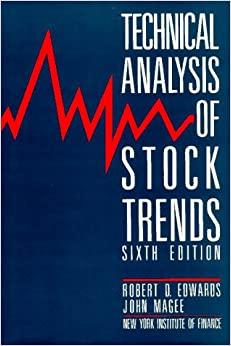Answered step by step
Verified Expert Solution
Question
1 Approved Answer
relevant. The yield to maturity ( YTM ) is the rate of return earned on a bond if it is held to maturity. It is
relevant.
The yield to maturity YTM is the rate of return earned on a bond if it is held to maturity. It is the interest rate that forces the present value of the bond to equal the present values
of the interest payments received during the life of the bond and the maturity value received at the bond's maturity. Calculate YTM using a financial calculator by entering the
number of payment periods until maturity for N the price of the bond for PV the interest payments for PMT and the maturity value for FV Then solve for IYR YTM Remember,
you need to make the appropriate adjustments for a semiannual bond and realize that the calculated IYR is on a periodic basis so you will need to multiply the rate by to obtain
the annual rate. In addition, you need to make sure that the signs for PMT and FV are identical and that the opposite sign is used for PV; otherwise, your answer will be incorrect.
The yield to call YTC is the rate of return earned on a bond when it is called before its maturity date. The equation for solving for the YTC is shown below:
Price callable bond
Calculate YTC using a financial calculator by entering the number of payment periods until call for N the price of the bond for PV the interest payments for PMT and the call price for
FV Then you can solve for IYR YTC Again, remember you need to make the appropriate adjustments for a semiannual bond and realize that the calculated IYR is on a periodic
basis so you will need to multiply the rate by to obtain the annual rate. In addition, you need to make sure that the signs for PMT and FV are identical and the opposite sign is used
for PV; otherwise, your answer will be incorrect.
A company is more likely to call its bonds if they are able to replace their current highcoupon debt with less expensive financing. A bond is more likely to be called if its price is
parbecause this means that the going market interest rate is less than its coupon rate.
Quantitative Problem: Ace Products has a bond issue outstanding with years remaining to maturity, a coupon rate of with semiannual payments of $ and a par
$ The price of each bond in the issue is $ The bond issue is callable in years at a call price of $
What is the bond's current yield? Do not round intermediate calculations. Round your answer to two decimal places.
What is the bond's nominal annual yield to maturity YTM Do not round intermediate calculations. Round your answer to two decimal places.
What is the bond's nominal annual yield to call YTC Do not round intermediate calculations. Round your answer to two decimal places.
Assuming interest rates remain at current levels, will the bond issue be called?
The firm
call the bond.

Step by Step Solution
There are 3 Steps involved in it
Step: 1

Get Instant Access to Expert-Tailored Solutions
See step-by-step solutions with expert insights and AI powered tools for academic success
Step: 2

Step: 3

Ace Your Homework with AI
Get the answers you need in no time with our AI-driven, step-by-step assistance
Get Started


